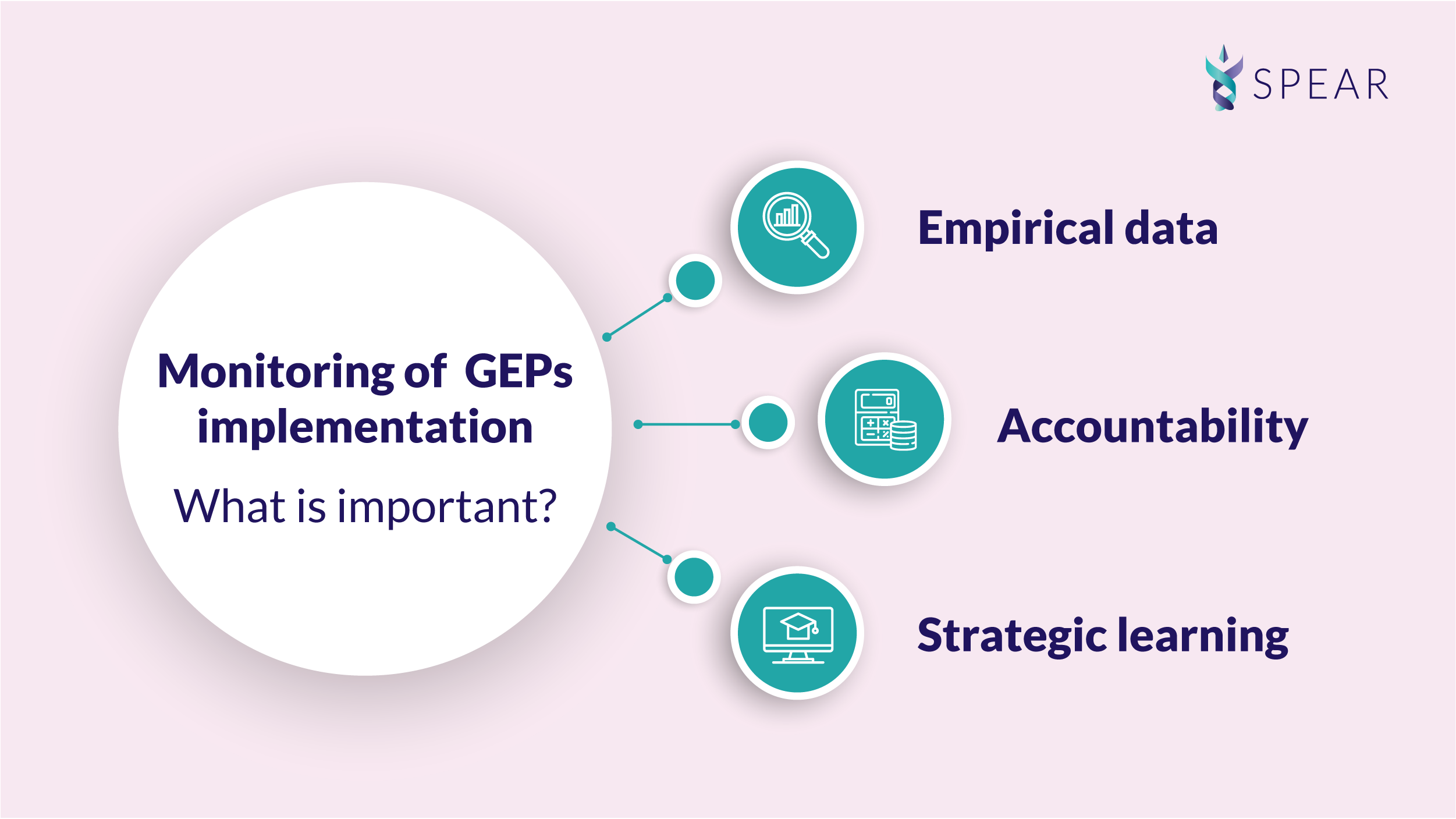The UNDP defines monitoring as "the ongoing process by which stakeholders obtain regular feedback on the progress being made towards achieving their goals and objectives" (UNDP 2009, 8). As this definition makes clear, monitoring needs to be closely connected to the GEP objectives and therefore to the measures that are foreseen in the GEP.
However, monitoring should not only focus on the progress towards reaching the objectives or the performance of specific measures but should also observe the implementation process itself. Therefore monitoring can deliver data and intelligence on two different dimensions: the progress towards the defined objectives and the transformational changes achieved so far, as well as on the strengths and weaknesses of the process of implementation itself. It is an important tool enabling organisations and especially the implementation teams to reflect upon their activities and improve their practices.
An important step when setting up a gender equality monitoring is the definition of meaningful and measureable indicators that are also accepted by organisational stakeholders. There are many indicators already available that measure the participation of men and women in research performing organisations, and higher education institutions or research funding organisations. Most importantly, the selected indicators need to reflect the objectives defined in each GEP. Hereby, both quantitative and qualitative indicators must be taken into consideration. Quantitative indicators are mostly used to monitor the change statistically and to get an overview on the issues, while qualitative data grasps the experiences and opinions, therefore, understanding the mechanisms behind these issues and capture “the quality of change” (EIGE 2020). For example, if one objective of the GEP is to focus on eliminating the leaking pipeline, a quantitative indicator measuring the proportion of women at different career stages would be advisable to see where one starts and how the progress is going. However, if one concentrates on processes behind the leaky pipeline e.g. looking at decision-making processes in promotion/recruitment or targeting the organizational culture, qualitative measurements should be the tool of choice. These indicators should be able to measure changes in a short- but also long-term perspective. Furthermore, to be meaningful the indicators need to be benchmarked and compared for instance over a longer period of time, or with data from other research performing organisations. Benchmarking of indicators allows assessing the achieved progress in comparison to other organisations or the national average. In doing so, it is important to choose the organisations for benchmarking very carefully. It might be wise not only to benchmark an organisation against the best performing organisations but also against comparable organisations.
However, besides assessing progress monitoring also has other functions. Especially in organisations that have just started to tackle gender inequalities, monitoring is also important to raise awareness of the existing inequality between men and women working in the organisations. It can provide empirical evidence on gender inequalities, which allows to start a conversation about this topic and to discuss ways to tackle inequalities. Therefore, it is important to publish the monitoring results in a report and communicate the main findings within the organisation, but also to the wider public. Consequently, monitoring results should be published regularly, e.g. on an annual basis and disseminated as broad as possible.
Monitoring the GEP implementation also allows creating accountability within the organisations as it makes the progress towards reaching the defined objectives tangible. The management who has agreed to the GEP objectives needs to explain why progress has been made or why it has come to a standstill. Therefore, monitoring can be a powerful tool to create accountability and responsibility for promoting gender equality within a research performing or funding organisation. Accountability becomes even stronger if progress needs to be reported to external stakeholders like funding agencies or ministries. Therefore, monitoring efforts and procedure need to be linked to the governance of these organisations.
When setting up a monitoring we are often asked what data needs to be collected and which indicators are relevant. However, there is no easy and ready-made solution or answer to this question: As stated above it is important that the data and indicators correspond with the objectives defined in the GEP. There are some resources that are helpful for setting up a monitoring and defining concrete indicators: For instance the GEAR Tool gives an overview on some basic quantitative and qualitative indicators that should be included into a GEP monitoring. In addition, the She Figures can be used as an inspiration for developing indicators and the EFFORTI toolbox provides suggestions for indicators measuring short to long-term effects of different gender equality measures.
Furthermore, it is important that the collection of data for monitoring purposes is processed efficiently. Monitoring is a continuous task that needs to be performed routinely. Therefore, the data collection needs to be integrated into organisational procedures and practices and should be done with as little extra effort as possible. The resource efficiency of data collection needs to be considered when constructing and defining indicators for monitoring purposes. It is also advisable to make an inventory of data and data collection methods already in place in an organisation - irrespective whether they are collecting gender disaggregated data or not. This overview of already existing data sources and data collection efforts is helpful to identify synergies and to coordinate processes and procedures.
Overall monitoring is an important feature of GEP implementation as it provides relevant empirical evidence on the progress towards transformational change, creates accountability and facilitates strategic learning.


